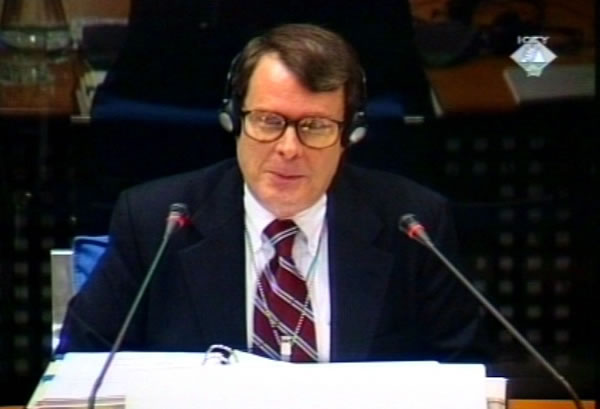Home
"A WELL-COORDINATED DUET" – KARADZIC AND KRAJISNIK
Prosecution expert testifies about the role that the accused Momcilo Krajisnik played in the "division of labor" at the top of the Serbian Democratic Party (SDS) in 1991 and 1992
 Patrick Treaner, witness at the Momcilo Krajisnik trial
Patrick Treaner, witness at the Momcilo Krajisnik trial Aggressive and often vulgar rhetoric of Radovan Karadzic dominated the recordings of intercepted conversations presented by the prosecution at the trial of Momcilo Krajisnik. Karadzic often discussed over insecure lines and without any qualms topics that were of sensitive nature, to say the least, such as the secret arming, mobilization and preparations for the war.
Although Krajisnik, as well, would swear sometimes, in those conversations he sounded much more reticent, calm and cautious. However, according to the minutes from the closed sessions of the Assembly, the SDS Main Board and other Bosnian Serb institutions – which the prosecution is tendering into evidence in the course of the marathon testimony of Patrick Treanor – Krajisnik's attitudes were no less radical than Karadzic's, the prosecution claims. It says that Krajisnik’s role in the preparations for the takeover of power and other events that followed was no less important than Karadzic's. In the "division of labor" at the top of the SDS, accoring to the prosecutors, Krajisnik had a key role to control the Assembly and its deputies and through them to direct the events in the field.
Among the documents admitted into evidence during Treanor's testimony were the minutes from the session of the Assembly of the Serbian People in BH held on 25 February 1992, which dealt with the Lisbon talks. The talks were on-going at the time and dealt with restructuring BH on the basis of ethnicity-based "constituent units". The Assembly speaker, Momcilo Krajisnik, summed up the options that, according to him, the Serbian people in BH had.
"The Serbian people has two options now: the first is to fight with political means, including the exchange of territory and population, and to get as much as possible; the second is to pull out from the talks and to take our territories by force. War has always been our business. We do not need a confederal Bosnia and Herzegovina, it is unreasonable, we need a monolithic Serbian state."
In the effort to create the "monolithic Serbian state", Krajisnik chaired the sessions of the Constitutional Commission and is credited with drafting the Constitution of the Serbian Republic of BH and the relevant implementation legislation, adopted at the session held on 28 February 1992 in Sarajevo.
According to the prosecution’s legal expert, the territory of the future Serbian state is "fairly imprecisely" defined in those documents. It was to include Serbian autonomous regions, Serbian municipalities and other Serbian "entities", including the areas where genocide was committed against the Serbs in World War II. According to the Constitution, the state with ill-defined borders was a part of the federal state of Yugoslavia.
At the same session of the Assembly, it was stressed that the "enthusiasm of the leadership of the Autonomous Region of Krajina in Banja Luka to proclaim the republic and unite with the Serbian Krajina in Croatia had to be curbed", because such a solution might cause negative reactions of the international community. Witness Treanor quoted the speech by "Mr. Cizmovic", coordinator for relations with Serbian autonomous regions, who proposed, among other things, that "our leaders, Karadzic and Krajisnik be sent to Banja Luka to solve the problem."
Treanor assesses that in the early nineties Krajisnik was one of the "most popular politicians" among Bosnian Serbs; the point which is illustrated by the fact that he got the most votes in the election for the members of the Main Board of the SDS. Krajisnik and Karadzic were, the prosecution argues, a "well-coordinated duet" working on the shaping and implementation of the SDS policy.
